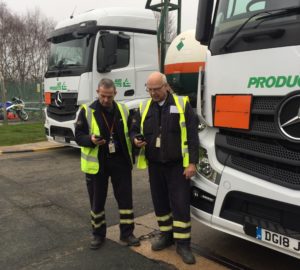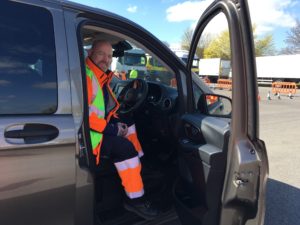Driver safety
Driver safety: Reducing preventable traffic accidents
Electric, diesel, autonomous, petrol or hydrogen-powered – no matter what your preference, the facts remain – driving is an integral part of our day to day lives. But with data suggesting that one in three road crashes involve a vehicle driven as part of someone’s job, safety at work is a central concern. Graham Hall, European Logistics Manager at Air Products explains how new technology introduced last year has already seen the business reduce preventable traffic accidents by 23%.
 With such a reliance on the vehicle, it’s hardly surprising that safety remains a challenge. Such is the scale of the issue that, last Autumn, Highways England introduced ‘space invaders’, a campaign dedicated to highlighting the risks of tailgating, while police forces across the UK are targeting mobile phone use this Spring. The message is clear ‘don’t be distracted, just drive’.
With such a reliance on the vehicle, it’s hardly surprising that safety remains a challenge. Such is the scale of the issue that, last Autumn, Highways England introduced ‘space invaders’, a campaign dedicated to highlighting the risks of tailgating, while police forces across the UK are targeting mobile phone use this Spring. The message is clear ‘don’t be distracted, just drive’.
It’s a good philosophy and one that should be applied to all aspects of driver safety.
At Air Products, the nature of our work as a major industrial gas manufacturer means that we operate a sizeable fleet with over 350 drivers and 278 vehicles active across the UK. Safety is part of our business culture – for us, the only acceptable target or goal is zero incidents and accidents. With that in mind, we have introduced unique technology that enables us not just to track what is happening but – critically, to work with our drivers to understand why.
Working in partnership with a UK telematics supplier, we have developed and implemented a fully integrated vehicle telematics and event recording camera solution to give us that understanding.
The telematics system captures information from the vehicle’s onboard computer. This allows us to assess not just how efficient the driving is, but also how safe it is, considering areas such as over-revving and idling. The forward-facing event recording cameras work simultaneously and are connected to, and triggered by, the trailer Roll Stability System as well as a G-force sensor in the camera itself. They can also be activated manually, should a driver want to capture a situation as it’s unfolding.
By combining data from both systems, we can support a data-enabled driver coaching programme that is making a noticeable difference to behaviour and performance.
How does it work?
All drivers have an assigned coach who works with them, using a state-of-the-art app to discuss and improve driving style. If the driver has ‘an event’, their coach receives a notification by email and phone, enabling them to view the video footage captured from the vehicle and take steps to coach the driver accordingly.
Thanks to recent upgrades, it’s now possible for our coaching team to share the event video safely with the driver much closer to the time the notification is triggered and received. This means the event is fresh in the driver’s mind, facilitating quick learning and improvement. When safe to do so, the driver can review the video, read the in-app comments from their coach and respond. This speeds up the coaching process and experience, especially beneficial where drivers work long hours or are based in remote locations.
The use of video has proved key. Not only does it serve as a deterrent, it’s also non-subjective, allowing the driver and coach to review real-live scenarios rather than debating the reason for the activation. In all of this, the emphasis is on two-way dialogue and preventative coaching and training. Positive behaviour is identified and commended, and often drivers can be exonerated in the event of an incident.
Of course, technology like this can be overwhelming, but the app has been designed in an engaging way with each driver able to access a league table and see how they are performing compared to the wider driver group. Drivers can also scrutinise specific aspects of their own performance using a ‘how was my day’ feature. This operates on a simple traffic light system, with green indicating good performance, yellow highlighting minor points and red illuminating real areas of concern.
We’re already seeing a marked improvement – driver logins have increased by 130% over the last year, and there’s been an immediate impact on safety performance too, with on-road preventable vehicle accidents down by 23%.
The drivers themselves have also been really supportive – three quarters of them even voted in favour of linking the safety system into a performance related pay scheme – and now, after significant success in the UK, we have rolled the technology out in Europe, with 80% of our vehicles equipped with it.
Of course, the journey to zero accidents and incidents continues. Key to this is recognising that, even with all the preventative coaching and training, our drivers are only human and everyone makes mistakes.
We’ve gone far beyond UK regulations by specifying the latest generation of emergency braking systems when purchasing new vehicles and we are working on wider initiatives linked to fatigue detection and slow speed manoeuvring giving protection to vulnerable road users. All of this will ultimately feed into our data-enabled driver coaching programme and help to ensure best practice across our business and its operations.
It can be all too easy to de-personalise health and safety initiatives. Clever use of technology is taking these issues out of the boardroom and putting the focus firmly on the very real and human implications that any accident can bring. There’s a lesson here for all of us.
 Alan Graham has been driving for Air Products for almost six years and was recently recognised by the company and its partner Mercedes-Benz Trucks UK Ltd for his outstanding performance when he was selected as a finalist in our Driver of the Year competition.
Alan Graham has been driving for Air Products for almost six years and was recently recognised by the company and its partner Mercedes-Benz Trucks UK Ltd for his outstanding performance when he was selected as a finalist in our Driver of the Year competition.
“The coaching programme has definitely had an impact on me – I drive differently now. Drivers always used to drive to the speed limit, now – because of what we’ve learnt, we drive within it. Most of us use an economy setting that restricts our speed. It’s not just about the fuel efficiency, it helps me feel less stressed as I’m changing lane and changing gear far less. It only adds a few minutes to the journey but it’s so much safer,” Alan said.
“What I really like about our approach to safety is that it’s two-way. With the cameras, I don’t feel like we are being watched in a bad way – they can help show we’re not at fault. I turned my camera on manually the other day because a car alongside me, towing another car, was losing control. It’s reassuring to know that if anything had happened, I would’ve had the footage to show it unfolding.
“We’re actually involved in the decisions and can feed back to our supervisors on what we are finding helpful and what else we need. At the moment we’re testing more sensors on our vehicles as well as reversing and side cameras.
“The league table is good too. Although you can only see your own name, you know how you’re ranked compared with other drivers and that really makes you want to improve. I’ve learnt a lot and find myself passing tips on to the other drivers. It’s all really making a difference.”
Driver safety: Reducing preventable traffic accidents
Graham Hall, European Logistics Manager at Air Products explains how new technology introduced last year has already seen the business reduce preventable traffic accidents by 23%.
Safety & Health Practitioner
SHP - Health and Safety News, Legislation, PPE, CPD and Resources Related Topics
Horticulture company fined after lorry driver suffers life changing injuries
Drug and alcohol testing in a UK airport environment
Unleashing the power of emerging technologies in EHS

 With such a reliance on the vehicle, it’s hardly surprising that safety remains a challenge. Such is the scale of the issue that, last Autumn, Highways England introduced ‘space invaders’, a campaign dedicated to
With such a reliance on the vehicle, it’s hardly surprising that safety remains a challenge. Such is the scale of the issue that, last Autumn, Highways England introduced ‘space invaders’, a campaign dedicated to  Alan Graham has been driving for Air Products for almost six years and was recently recognised by the company and its partner Mercedes-Benz Trucks UK Ltd for his outstanding performance when he was selected as a finalist in our Driver of the Year competition.
Alan Graham has been driving for Air Products for almost six years and was recently recognised by the company and its partner Mercedes-Benz Trucks UK Ltd for his outstanding performance when he was selected as a finalist in our Driver of the Year competition.